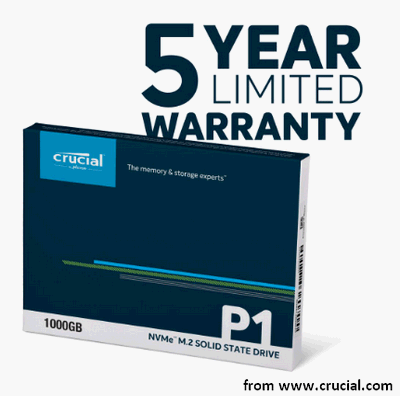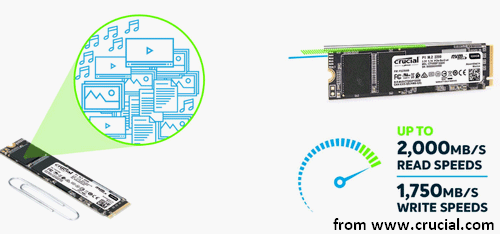According to the computer, the new Crucial P1 SSD is equipped with fast speed and large capacity; it can help you get in the game faster and store all your memories easily. As the company’s first consumer drive, this SSD also has many other advantages waiting for you to discover.
The newly released Crucial P1 SSD is actually a very novel product of Crucial Technology.
- Equipped with the NVMe interface, Crucial P1 SSD is the first consumer SSD of the company.
- Besides, it is the second consumer SSD on the market which adopts the four bit per cell (QLC) NAND flash memory; the first one is Intel SSD 660p.
- Though it is the second QLC (3D Quad-Level Cell) SSD from Micron (the first one is 5210 ION enterprise SATA SSD), it is actually the first consumer NVMe SSD that Micron has actually shipped.

Crucial P1 SSD Review
According to the company, the Crucial P1 SSD is always your good choice whether you are trying to get in the game faster or store all your precious memories. Here, I’ll introduce more details of this solid-state drive.
Capacity, Speed and Random 4K Performance
Capacity:
When it was firstly released, the Crucial P1 SSD provides only 2 choices in terms of capacity – 500GB and 1T. Yet, the flagship 2TB drive is coming soon.
The Crucial P1 SSD offers 1GB DRAM per 1TB NAND ratio DRAM; it is much better when compared to the Intel 660p, which offers only 256MB of DRAM, regardless of the drive capacity. The extra DRAM of this Crucial consumer SSD can be used to enable marginal improvements on both benchmarks and workloads. In this way, it is able to deal with large amounts of data quickly and the firmware of the drive may be simplified slightly.
Speed:
Well, as for the speed, there is a little difference among different model.
- 2TB model: the sequential read speed and write speed are respectively up to 2,000 MB/s and 1,750 MB/s.
- 1TB model: the sequential read speed and write speed are respectively up to 2,000 MB/s and 1,700 MB/s.
- 500GB model: the sequential read speed and write speed are respectively up to 1,900 MB/s and 905 MB/s.

The Hybrid-Dynamic Write Acceleration technology of Crucial has been applied to the P1 SSD in order to achieve fast speed.
Random 4K performance:
- 2TB model: 250,000 IOPS for both reads and writes.
- 1TB model: up to 170,000 IOPS for reads and up to 240,000 IOPS for writes.
- 500GB model: 90,000 IOPS for reads and 220,000 IOPS for writes.
Quad-Level Cell NAND
As I have mentioned at the beginning of this article, the Crucial P1 SSD includes a Quad-Level Cell NAND (4 bits per cell); it is actually the latest leading edge NAND technology comes after SLC (1 bit per cell), MLC (2 bits per cell) and TLC (3 bits per cell).
The new QLC NAND is doing better than others in the aspect of reducing cost and storing more bits of data per cell (it increases about 33% when compared to TLC). Yet, there is still a long way to go – there are a lot of barriers to overcome in terms of performance and endurance.
As a result, you are advised to backup all data (or at least the important data) on your SSD in case of any unexpected accidents.
Warranty and Endurance
The Crucial company provides you with a 5-year limited warranty; it supports thousands of validation hours, dozens of qualification tests, and a heritage of award-winning SSDs.
Yet, the endurance is not so ideal, as we can expect from a QLC SSD. For every 500GB of SSD capacity, it allows at most 100TB of data writes. This is equal to the 200TBW of endurance for the 1TB model. This is exactly the same as that of the Intel 660p powered by QLC.
According to statistics, the endurance of most 1TB NVMe SSDs is up to 600TBW (this is much better than the P1 model). Besides, the endurance of some new SSDs, such as Corsair MP510, is eight times more than the Crucial P1 SSD. What’s more, even the MX500 of Crucial provides almost twice the endurance.
Every time when data has been written to NAND, the cell will get damaged; this explains why the endurance of Crucial P1 SSD is not so good. In contrast, the life of SLC, MLC and TLC are respectively:
- 100,000 P/E (program/erase cycles)
- 10,000 P/E
- 3,000 P/E
User Comments :